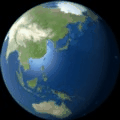EARTH 

Earth
Earth is a small planet in the vastness of space. It is one of nine planets that travel through space around the sun. The sun is a star -- one of billions of stars that make up a galaxy called the Milky Way. The Milky Way and as many as 100 billion other galaxies make up the universe.
Earth as a planet
Earth ranks fifth in size among the nine planets. It has a diameter of about 8,000 miles (13,000 kilometers). Jupiter, the largest planet, is about 11 times larger in diameter than Earth. Pluto, the smallest planet, has a diameter less than one-fifth that of Earth.
How Earth moves
Earth has three motions. It (1) spins like a top around an imaginary line called an axis that runs from the North Pole to the South Pole, (2) it travels around the sun, and (3) it moves through the Milky Way along with the sun and the rest of the solar system.
Earth's size and shape
Most people picture Earth as a ball with the North Pole at the top and the South Pole at the bottom. Earth, other planets, large moons, and stars -- in fact, most objects in space bigger than about 200 miles (320 kilometers) in diameter -- are round because of their gravity. Gravity pulls matter in toward the center of objects. Tiny moons, such as the two moons of Mars, have so little gravity that they do not become round, but remain lumpy instead.
Earth and its moon
Earth has one moon. Pluto also has one moon, while Mercury and Venus have none. All the other planets in our solar system have two or more moons. Earth's moon has a diameter of 2,159 miles (3,474 kilometers) -- about one-fourth of Earth's diameter.
Earth's spheres
Earth is composed of several layers, or spheres, somewhat like the layers of an onion. The solid Earth consists of a thin outer layer, the crust, with a thick rocky layer, the mantle, beneath it. The crust and the upper portion of the mantle are called the lithosphere. At the center of Earth is the core. The outer part of the core is liquid, while the inner part is solid.
The atmosphere
Air surrounds Earth and becomes progressively thinner farther from the surface. Most people find it difficult to breathe more than 2 miles (3 kilometers) above sea level. About 100 miles (160 kilometers) above the surface, the air is so thin that satellites can travel without much resistance. Detectable traces of atmosphere, however, can be found as high as 370 miles (600 kilometers) above Earth's surface. The atmosphere has no definite outer edge but fades gradually into space.
History of Earth
The history of Earth is recorded in the rocks of Earth's crust. Rocks have been forming, wearing away, and re-forming ever since Earth took shape. The products of weathering and erosion are called sediment. Sediment accumulates in layers known as strata. Strata contain clues that tell geologists about Earth's past. These clues include the composition of the sediment, the way the strata are deposited, and the kinds of fossils that may occur in the rock.
Cycles on and in Earth
Earth can be thought of as a huge system of interacting cycles. In each cycle, matter and energy move from place to place and may change form. Eventually, matter and energy return to their original condition and the cycle begins again. The cycles affect everything on the planet, from the weather to the shape of the landscape. There are many cycles on and within Earth. A few of the most important are (1) atmospheric circulation, (2) ocean currents, (3) the global heat conveyor, (4) the hydrologic cycle, and (5) the rock cycle.
Life on Earth
Many rocks contain fossils that reveal the history of life on Earth. A fossil may be an animal's body, a tooth, or a piece of bone. It may simply be an impression of a plant or an animal made in a rock when the rock was soft sediment. Fossils help scientists learn which kinds of plants and animals lived at different times in Earth's history. Scientists who study prehistoric life are called paleontologists.
Many scientists believe that life appeared on Earth almost as soon as conditions allowed. There is evidence for chemicals created by living things in rocks from the Archean age, 3.8 billion years old. Fossil remains of microscopic living things about 3.5 billion years old have also been found at sites in Australia and Canada.












